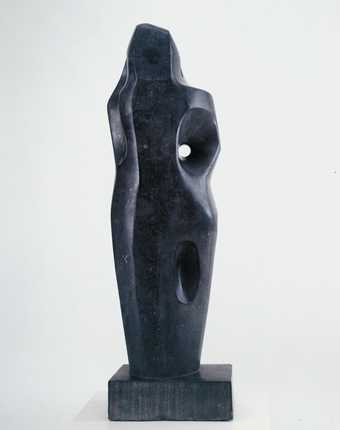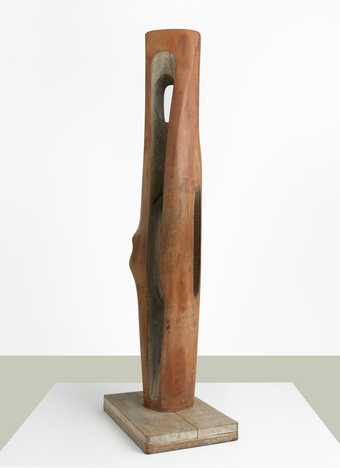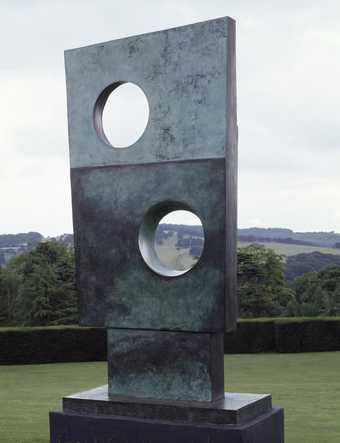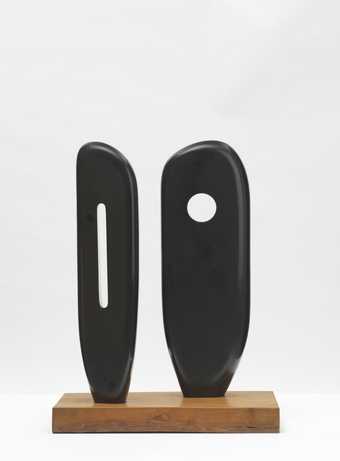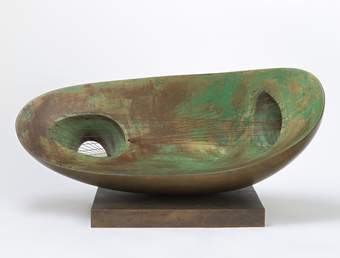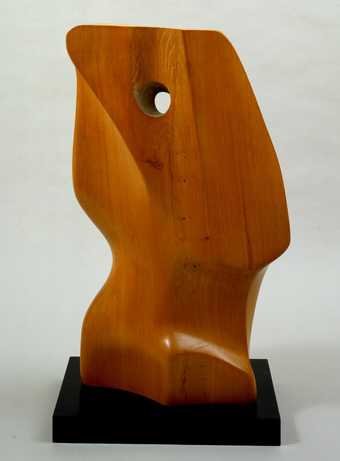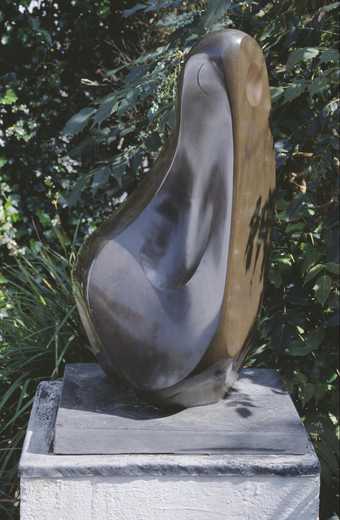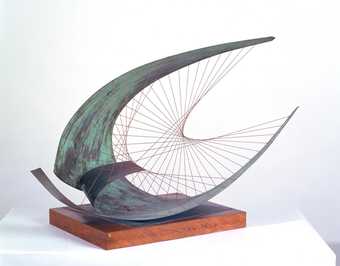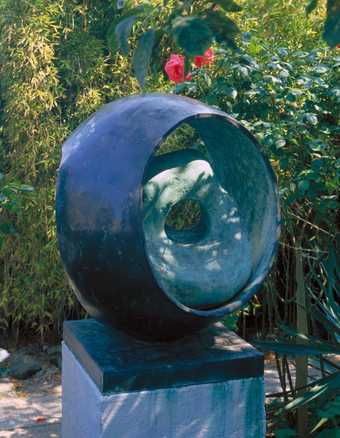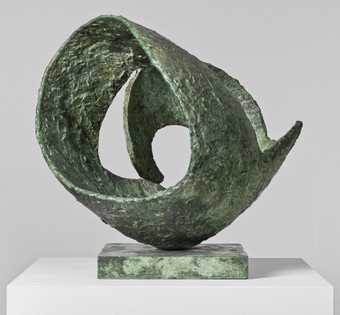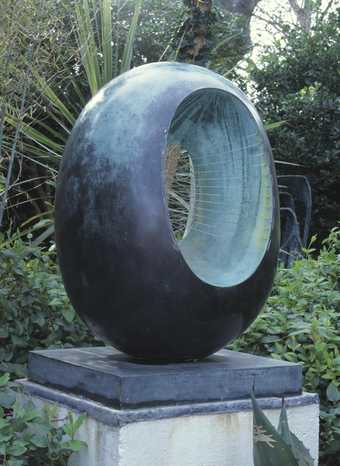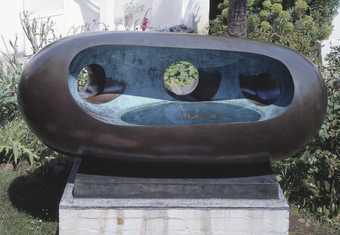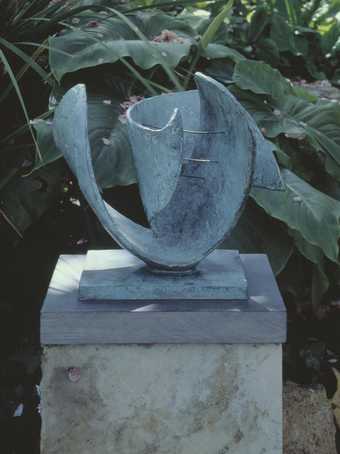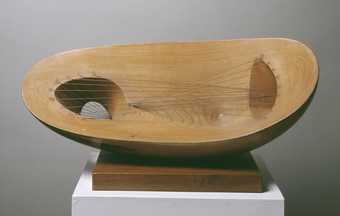In Barbara Hepworth Museum and Sculpture Garden
- Artist
- Dame Barbara Hepworth 1903–1975
- Medium
- Bronze
- Dimensions
- Object: 2693 × 1370 × 740mm
- Collection
- Tate
- Acquisition
- Presented by the executors of the artist's estate 1980
- Reference
- T03140
Summary
Figure for Landscape 1959–60 is a large, hollow, asymmetrical sculpture in bronze by the British artist Barbara Hepworth. It was cast at the Morris Singer foundry in London from a plaster original prepared by Hepworth and her assistants in her studio, the former Palais de Danse in St Ives, Cornwall. Renowned for her carving of stone and wood, Hepworth’s move into metal, initially wrought and then cast, afforded her a broader vocabulary of sculptural forms. To produce Figure for Landscape, liquid plaster would have been applied to expanded aluminium over a wooden armature. The artist would then have manipulated the plaster as it set. The plaster may then have been carved further when dried, as was consistent with Hepworth’s practice.
Although the hollowed-out form had begun to be established as the mainstay of Hepworth’s art in the mid-1940s, the plastic qualities of bronze allowed her to achieve a degree of hollowing out that she could not have achieved in wood or stone. The curators and cataloguers of Hepworth’s work in Tate’s collection, Matthew Gale and Chris Stephens, have highlighted the way in which the form of this figure appears to echo that of Auguste Rodin’s Balzac 1892–7 (Musée Rodin, Paris, posthumous cast). The monumentality of that work is emphasised by the wrapping of the figure in a copious gown, and it is as a draped or shrouded figure that one might read Hepworth’s Figure for Landscape. Specifically, the asymmetrical form is suggestive of a mother holding a child in one arm. (For the full catalogue entry on this work see http://www.tate.org.uk/art/artworks/hepworth-figure-for-landscape-t03140/text-catalogue-entry, accessed 29 July 2015.)
Landscape became the dominant point of reference in Hepworth’s own account of her sculpture from the 1940s onwards. In essence, her vocabulary of hollowed-out forms followed an idea of landscape as an enveloping protector of an inferred fragile figure. This work is unusual, however, both in the explicit nature of the landscape reference in its title and in the figurative nature of the sculpture. The notion of a figure in the landscape conjured by the title suggests the continuation of a well-established comparison between Hepworth’s sculpture and the standing stones in the landscape around her home town of St Ives. More specifically, it echoes her own verbal description of an important change in her attitude to landscape. In 1952 Hepworth recalled how her move to Cornwall had led to a new understanding of landscape: ‘I was the figure in the landscape and every sculpture contained to a greater or lesser degree the ever-changing forms and contours embodying my own response to a given position in the landscape’ (quoted in Herbert Read, Barbara Hepworth: Carving and Drawings, London 1952, section 4, unpaginated). This view of landscape prompts sculptures with enveloping forms that can be read as expressions of the artist’s experience of being in a place. In contrast, Figure for Landscape becomes the embodiment of the subject of that experience.
Further reading
Alan Bowness (ed.), The Complete Sculpture of Barbara Hepworth 1960–69, London 1971, no.287.
Matthew Gale and Chris Stephens, Barbara Hepworth: Works in the Tate Gallery Collection and the Barbara Hepworth Museum, St Ives, London 1999, pp.200–2.
Chris Stephens
May 2015
Does this text contain inaccurate information or language that you feel we should improve or change? We would like to hear from you.
Catalogue entry
Dame Barbara Hepworth
1903-1975
T03140 Figure for Landscape 1959-60
BH 287; cast 1/7
Bronze on integral bronze base 2600 x 1250 x 675 (102 3/8 x 49 1/4 x 26 1/2)
Cast numerals on top of base '1/7' and 'Barbara Hepworth | 1960' back right, and cast foundry mark on back of base 'FOUNDERS | MORRIS | SINGER | LONDON' t.r.
Presented by the executors of the artist's estate, in accordance with her wishes, 1980
Exhibited (ý = unidentified cast, ü = other cast):
Barbara Hepworth: An Exhibition of Sculpture from 1952-1962, Whitechapel Art Gallery, May-June 1962 (60ý, repr.)
Netherlands Art Foundation, Keukenhof and Breda, summer 1962
Beeldhouwwerken en Tekeningen van Barbara Hepworth, Rietveld Pavilion, Rijksmuseum Kröller-Müller, Otterlo, May-July 1965 (26ü, repr.)
Barbara Hepworth, Marlborough-Gerson Gallery Inc., New York, April-May 1966 (3ý, repr.)
Barbara Hepworth, Tate Gallery, April-May 1968 (108ü, repr. p.35)
Sculpture Exhibition: City of London Festival, St Paul's Churchyard, June 1968 (18ý)
Literature:
Alan Bowness (ed.), The Complete Sculpture of Barbara Hepworth 1960-69, 1971, p.30, no.287, repr. pls.28-9
Herbert Christian Merillat, Modern Sculpture: The New Old Masters, 1974, p.113, repr. between pp.142 and 143, pl.2 and on front cover
Nancy Cusick, 'Three in Washington D.C.', Women Artists News, vol.7, no.3, Fall 1981, p.9
Tate Gallery Acquisitions 1980-2, 1984, p.117, repr.
W.J. Strachan, Open Air Sculpture in Britain: A Comprehensive Guide, 1984, p.98, no.191, repr. p.99
Reproduced:
G.S. Whittet, 'You Can't Write Off the British', Studio, vol.164, no.832, Aug. 1962, p.72
R.W.D. Oxenaar, 'Barbara Hepworth: Mens, beeld en landschap', Museumjournal voor Moderne Kunst, vol.10, no.6, June 1965, p.162
A.M. Hammacher, Barbara Hepworth, 1968, rev. ed. 1987, pp.132-3, pl.108 & p.156, pl.134
Barbara Hepworth: A Pictorial Autobiography, 1970, p.110
Margaret A. Robinette, Outdoor Sculpture: Object and Environment, 1976, p.62
David Fraser Jenkins, Barbara Hepworth: A Guide to the Tate Gallery Collection at London and St Ives, Cornwall, 1982, p.33
Peter Davies and Tony Knipe (eds.), A Sense of Space: Sculpture in Landscape, 1984, p.27
Michael Williams, People and Places in Cornwall, 1985, p.59
Peter Fuller, 'The Visual Arts' in Boris Ford (ed.), Cambridge Guide to the Arts in Britain, vol.9: Since the Second World War, 1988, p.101
Michael Tooby, An Illustrated Companion to the Tate St Ives, 1993, p.13
Displayed in the artist's garden, Barbara Hepworth Museum, St Ives
At over two and a half metres high (eight and a half feet) Figure for Landscape
is a substantial presence. It was made during a period in which Barbara Hepworth undertook a series of commissions for bronzes which were architectural in scale and setting; they included Meridian, 1958-60 (BH 250) in London, related to Garden Sculpture (Model for Meridian)
(Tate Gallery T03139), and Single Form, 1961-4 (BH 325) in New York related to Single Form (September)
(Tate Gallery T03143). Although sharing some of their monumental character, Figure for Landscape
remained within the physical limitations of manufacture in her workshop and - as the title announces - within the context of nature.
Around the time of making the sculpture, Hepworth discussed the associations between her work and landscape which were of long-standing importance. She explained to Edouard Roditi that a sculpture 'is for a specific landscape. My own awareness of the structure of the landscape ... provides me with a kind of stimulus. Suddenly an image emerges clearly in my mind, the idea of an object that illustrates the nature or quality of my response' (Edouard Roditi, Dialogues on Art, 1960, p.92). This related to Hepworth's view of the figure's emergence from and integration with the landscape. She recalled glimpsing an isolated priest on the Greek island of Patmos:
This single human figure then seemed to me to give the scale to the whole universe, and this is exactly what a sculpture should suggest in its relationship to its surroundings: it should seem to be at the centre of the globe, compelling the whole world around it to rotate, as it were, like a system of planets around a central sun.
(ibid., p.101)
Hepworth also saw some of this quality in the relationship of the Neolithic stones to the landscape of Cornwall: 'Any standing stone in the hills here is a figure, but you have to go further than that ... To resolve the image so that it has something affirmative to say is to my mind the only point' (Bowness 1971, p.13). These conceptual threads - of placement within a specific location and a compelling relationship to it - evolved in Hepworth's earlier works, such as Curved Form (Trevalgan) (Tate Gallery T00353), which offered an abstract response to the feeling of being in a particular landscape. That these ideas are channelled into Figure for Landscape is acknowledged in the explicitly figural reference of the title, even as the vertical form evokes that of such abstractions as Single Form (Eikon), 1937-8 (Tate Gallery T00697). The quality of an enclosed but rising form suggests the emergence of the sculptural object from the landscape to which she also alluded (ibid., p.14).
This enclosure continues the artist's preferred hollowing to allow light to enter the solid form. It is significant that Hepworth described this process as conveying 'a sense of being contained by a form as well as of containing it' (Roditi, Dialogues on Art, 1960, p.100). In relation to the over life-size Figure for Landscape
such an analogy suggests the 'allusions to the womb and to the caring, sheltering function of the mother' that Claire Doherty has recognised in other sculptures by Hepworth (Claire Doherty, 'Re-reading the Work of Barbara Hepworth in the Light of Debates on "the Feminine"' in David Thistlewood (ed.), Barbara Hepworth Reconsidered, 1996, p.168). It may also encourage an extension of the interpretation of her pre-war sculpture in the light of Melanie Klein's psychoanalytic theory of art as a reparative act for the infantile desire to attack the mother's womb (Anne M. Wagner, ' "Miss Hepworth's Stone Is
a Mother" ', ibid., pp.65-8).
The hollowing of the sculpture was a standard practice for Hepworth's carvings, but Figure for Landscape
was the first in which this wrapping was attempted in plaster for bronze. The exactly contemporary marble Image II
(Tate Gallery T00958) and guarea Epidauros
(Tate Gallery T03141) show her stylistic diversity and how far the forms were modified in response to the qualities of the different materials. The particular balance in Figure for Landscape
also suggests comparisons with the work of others. The equation of landscape and figure - especially in an enfolding form - was a central concern of Henry Moore, for whom it took on a specifically female embodiment in the hollowed shell of Reclining Figure (External Form), 1953-4 (Art Institute of Chicago, repr. Alan Bowness, ed., Henry Moore, Volume 2: Sculpture and Drawings, 1949-54, 2nd ed. 1965, LH 299, pl.28). However, the monumental aspect also evokes Auguste Rodin's famously self-possessed Balzac, 1892-7 (Carrefour Vavin, Paris, repr. Ionel Jianou and C. Goldscheider, Rodin, Paris 1969, pl.86), in which the figure is wrapped in a gown. This similarity encouraged Herbert Merillat to remark that the Hepworth was 'definitely human in contour, suggesting a mummy case' (Merillat 1974, p.113). In the preceding years there were other examples of contemporaries working with similar qualities of enclosure. More pertinent to the opening of the interior is Arp's abstract Ptolemy I, 1953 (Fondation Arp, Clamart) in which space is held by diagonally encircling forms; an illustration of Arp's sculpture served as a frontispiece for Herbert Read's The Art of Sculpture
(1954, repr. [p.iv]) of which Hepworth was a joint dedicatee (with Moore and Gabo). Hepworth herself continued to explore the themes and processes undertaken in Figure for Landscape, in Sea Form (Atlantic), 1964 (BH 362, Museum of Fine Arts, Dallas, repr. Bowness 1971, pls.103,104) and Rock Form (Porthcurno), 1964 (BH 363, Cornwall County Council, repr. ibid., pls.105,106). Each explored the identification of figure and landscape through the penetration of an upright, vaguely figurative, mass by openings rather than the enclosure used for the earlier sculpture.
In making Figure for Landscape, plaster was applied to an expanded aluminium armature, following the method established since 1956. Amongst her assistants, Brian Wall recalled making the armature (interview with the author, 3 May 1996) and Tommy Rowe remembered helping Hepworth to apply the plaster (interview with the author, 16 Oct. 1996). It appears to have had two curved cross-braces to provide additional strength: the broad strut which intrudes above the lower hole in the back and the diagonal strip that bridges the front opening. The plaster was generously and vigorously applied, securing a richly textured surface that was then carved; this was the process that the artist explained in a contemporary letter to Herbert Read (29 Oct. 1961, Sir Herbert Read Archive, University of Victoria, B.C.). The shoulders of the form particularly show this carving. In profile, the back appears to be quite flat so that, in common with many of Hepworth's sculptures, the primary effect is frontal.
The casting of the bronze was subject to delay. The sculptor had to distribute works to different foundries in order to get them completed during the run-up to her 1960 Zurich exhibition (Galerie Charles Lienhard). In September 1959 she had asked Morris Singer Ltd if they had time to cast an unspecified 'large bronze say 6-7 feet, to be ready by the end of next March' (Hepworth to Morris Singer Ltd., 21 Sept. 1959, TGA 965). By November their schedules prevented casting 'my seven foot figure' (Hepworth to Morris Singer Ltd., 2 Dec. 1959, TGA 965). As she told Read: 'There remains but one now - a 7ft [sic] figure - which so far I haven't been able to persuade anybody to do for me, as the foundries are booked up' (1 Dec. 1959, Sir Herbert Read Archive, University of Victoria, B.C.). Eventually Morris Singer Ltd cast it in 1961, 1/7 being completed by September (Hepworth to Morris Singer Ltd., 20 Sept. 1961, TGA 965). This was the artist's copy - which came to the Tate - and it was patinated green, with greater intensity on the inner faces. Although it was listed in her solo exhibition in London (Barbara Hepworth, Gimpel Fils, May-June 1961, no.18), it was feared that it would not fit in the gallery (Kay Gimpel to Hepworth, 7 March 1961, TGA 965), and their records note it as 'not shown'. Nevertheless, it did appear in subsequent exhibitions and in 1968, the year of the artist's major retrospective at the Tate Gallery, two further casts passed into public collections: the San Diego Society of Arts (5/7) and the Stavanger Kunstfasening, Norway (6/7). Earlier casts are in the Hirshhorn Museum and Sculpture Garden, Smithsonian Institution, Washington D.C. (2/7) and Exeter University (4/7).
The size of the plaster had dictated that the hollow cast bronze had to be made in two parts. An inspection of the Tate's sculpture in 1983 revealed that the parts were bolted together with several bronze and five mild steel bolts which had rusted. Timber formers under the flared out base had also rotted and they, together with remains of moulding sand from inside the sculpture, were removed (Tate Gallery Conservation Records). The old drainage hole in the bottom of the sculpture had probably been blocked to arrest the appearance of iron staining from the inner bolts. A new drainage hole was made in 1983, and fitted with a gauze mesh set in 'Dow Corning' silicone rubber and attached to a pipe. The sculpture has weathered as a result of its position in the artist's garden; the perennial problems remain handling and leaf deposits, weather and bird lime. As a result of the 1983 inspection the surface was cleaned in preparation for the application of two coats of lacquer, the second including a matting agent. Lacquer proved hard to detect on a subsequent inspection and small areas of bronze disease have been noted (Tate Gallery Conservation Records).
Matthew Gale
March 1998
Explore
You might like
-
Dame Barbara Hepworth Bicentric Form
1949 -
Dame Barbara Hepworth Figure (Nanjizal)
1958 -
Dame Barbara Hepworth Squares with Two Circles
1963 -
Dame Barbara Hepworth Two Figures (Menhirs)
1964 -
Dame Barbara Hepworth Landscape Sculpture
1944, cast 1961 -
Dame Barbara Hepworth Figure (Nyanga)
1959–60 -
Dame Barbara Hepworth Coré
1955–6, cast 1960 -
Dame Barbara Hepworth Stringed Figure (Curlew), Version II
1956, edition 1959 -
Dame Barbara Hepworth Torso II (Torcello)
1958 -
Dame Barbara Hepworth Sphere with Inner Form
1963 -
Dame Barbara Hepworth Involute II
1956 -
Dame Barbara Hepworth Spring
1966 -
Dame Barbara Hepworth River Form
1965 -
Dame Barbara Hepworth Corymb
1959 -
Dame Barbara Hepworth Landscape Sculpture
1944


